Glencoe Math Course 2 Volume 1 Common Core Chapter 3 Integers
Page 191 Exercise 1 Problem 1
Because the first three operations close the set of integers:
Add
Subtract
Multiply
These operations will return a set of integers as a result.
When you divide two numbers, though, the result is when the first and second integers are not multiples of each other (In other words, when the second integer is not a factor of the first integer), Then, rather than an integer, the outcome will be the Ratio between the two integers.
Hence the term “rational” for such numbers.
Finally, we concluded that when we add, subtract, and multiply will return a set of integers as a result. and when we divide integers the outcome will be the Ratio between the two integers. Hence the term “rational” for such numbers.
Page 191 Exercise 1 Problem 2
The bottom of a snowboarding half-pipe is 5 meters below the top, Circle the integer you would you use to represent this position 5 (or)(−5)
In weather forecasting, negative numbers are used to show the temperature of a region.
On the Fahrenheit and Celsius scales, negative numbers are used to represent the temperature.
Finally, we concluded that the result to represent this position is (−5)
Page 194 Exercise 1 Problem 3
Given: $16
To write an integer.
A deposit increases the balance and thus it is best to take a positive integer
Therefore, the positive integer will be
⇒ 16
Finally, we concluded that the result is ⇒ 16
Page 194 Exercise 2 Problem 4
Given: A loss of 11 yards
To write an integer.
A loss of 11 yards is a decrease of the number of yards and thus it is best to take a negative integer.
Therefore, the negative integer will be
⇒ −11
A loss of 11 yards = −11
Finally, we concluded that the result is ⇒ −11
Page 194 Exercise 4 Problem 5
Given:−9=____
To evaluate the expression.
The absolute value of a number is the distance from the number to zero.
Therefore, the absolute value is
⇒ −9 = 9
Finally, we concluded that the result is ⇒ 9
Page 194 Exercise 5 Problem 6
Given: |18|−|−10| =____
To evaluate the expression.
The absolute value of a number is the distance from the number to zero.
Therefore, the absolute value is
|18|−|−10| = 18 − 10
=8
|18|−|−10| =8
The value of |18|−|−10| is 8
Page 194 Exercise 7 Problem 7
Given:{11,−5,−8}
To Graph the set of integers on a number line.
The given set is {11,−5,−8}
Here,11 Lies in the middle between 10 and 12, while−5 lies in the middle between−4 and−6 and −8 lies in the middle between−7 and−9
The graph on a number line
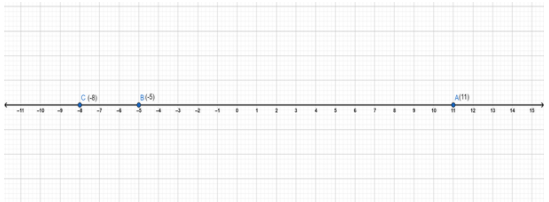
The given set of integers {11,−5,−8} is graphed on a number line.
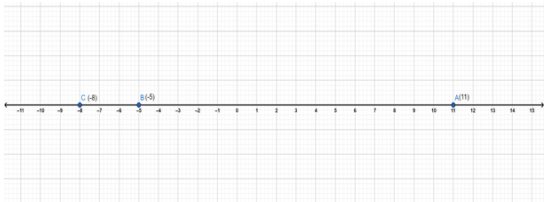
Page 194 Exercise 8 Problem 8
The absolute value of a number is positive because the distance of the number is always positive or zero if the number is zero.
Finally, we concluded that the absolute value of a number is positive since the distance is positive.
Page 195 Exercise 1 Problem 9
Given: A profit of $9
To write an integer.
A profit is an amount that was gained and thus it is best to use a positive integer.
Therefore, the positive integer will be
⇒ 9
Finally, we concluded that the result is ⇒ 9
Page 195 Exercise 2 Problem 10
Given: A bank withdrawal of $50
To write an integer.
A bank withdrawal decreases the balance of the bank account and thus it is best to use a negative integer.
Therefore, the negative integer will be
⇒ −50
Finally, we concluded that the result is ⇒ −50
Page 195 Exercise 3 Problem 11
Given: $53 below zero
To write an integer.
The temperature below zero is best described by a negative number.
Therefore, the negative integer will be
⇒ −53
Finally, we concluded that the result is ⇒−53
Page 195 Exercise 4 Problem 12
Given: 7 inches more than normal
To write an integer.
The number of inches more than normal is best described by a positive integer.
Therefore, the positive integer will be
⇒ 7
Finally, we concluded that the result is ⇒ 7
Page 195 Exercise 7 Problem 13
Given: 10 =____
To evaluate the expression.
The absolute value of a number is the distance from the number to zero.
Therefore, the absolute value is
⇒ 10 = 10
Finally, we concluded that the result is ⇒ 10
Page 195 Exercise 8 Problem 14
Given:−7−5 =____
To evaluate the expression.
The absolute value of a number is the distance from the number to zero.
Therefore, the absolute value is
⇒ −7 − 5 = 7 − 5 = 2
⇒ 2
Finally, we concluded that the result is ⇒ 2
Page 196 Exercise 13 Problem 15
Given: |−199.99|+|−39.99|+|−59.99|
To find the amount Mr. Chavez spent altogether.
The absolute value of a number is the distance of the number to zero.
Therefore, the absolute value is
|−199.99| + |−39.99| + |−59.9|
= 199.99 + 39.99+59.99
= $299.97
|−199.99|+|−39.99|+|−59.99| = $299.97
Mr. Chavez spends ⇒ $299.97 altogether.
Page 196 Exercise 14 Problem 16
Given: x = 3
To find the value of x?
The absolute value of a number is the distance of the number to zero.
Hence, x has to be 3 or −3 (since 3 and −3 lie a distance of 3 from zero).
Therefore, the absolute value is
⇒ 3 or −3
Finally we concluded that the value of x ⇒ 3 or − 3
Page 196 Exercise 15 Problem 17
The inequality is always true Because the absolute value of a number is positive.
Finally, we concluded that inequality is always true.
Page 196 Exercise 16 Problem 18
Given:
To find the expression that is not equal to the other three.
The absolute value of a number is the distance of the number to zero.
Evaluating each expression:
15 − |−5| = 15 − 5
= 10
|−4| + 6 = 4 + 6
= 10
− |7 + 3| = −10
|−10| = 10
Therefore, the expression does not equal the other three is
⇒ −|7 + 3| = −10
−|7+3| is the expression that does not equal the other three expressions.
Page 196 Exercise 17 Problem 19
Given:
1. − 11 °F
2. −10 °F
3. 10 °F
4. 11 °F
To find Which integer represents the temperature shown on the thermometer?
The integer−11 (thus below zero)is denoted on the thermometer and thus the temperature shown is −11 °F
Therefore, the integer represents the temperature shown on the thermometer A.(−11°F)
Finally, we concluded that the integer represents the temperature shown on the thermometer. (−11°F)
Page 197 Exercise 18 Problem 20
Given:
2 feet below flood level
To Write an integer for the situation?
The number of feet below flood level is represented by a negative integer
Therefore, the negative integer is −2
Finally, we concluded that the result is ⇒ −2
Page 197 Exercise 19 Problem 21
Given:
An elevator goes upto 12 floors
To Write an integer for the situation
The elevator goes up. Hence, it is represented by a positive integer.
Therefore, the positive integer is 12
Finally, we concluded that the result is ⇒ 12
Page 197 Exercise 20 Problem 22
Given: {3,−7,6}
Graph the given set of integers on a number line.
The graph of the number is the point on this line that corresponds to each number. 3Lies in the middle between 2and4
While−7lies in the middle between−6 and−8,and 6lies in the middle between 5 and 7

The given set of integers {3,−7,6} is marked on a number line.
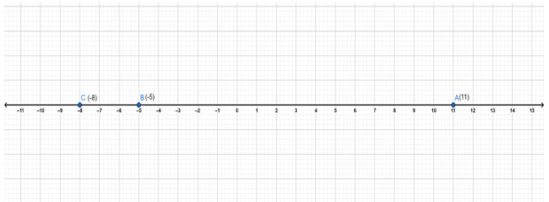
Page 197 Exercise 21 Problem 23
Given: (−2,−4,−6,−8)
To Graph the set of integers on a number line?
− 2 Lies in the middle between −1 and−3.While−4 lies in the middle between−3 and−5 , and −6 lies in the middle between−5 and−7,−8 Lies in the middle between −7 and -9

Finally, we Graph the set of integers on a number line.
Page 197 Exercise 22 Problem 24
Given: −12=____
To evaluate the expression.
The absolute value of a number is the distance from the number
The distance cannot be negative.
Therefore, the absolute value is
⇒ 12
Finally, we concluded that the result is ⇒ 12
Page 197 Exercise 23 Problem 25
Given: 7+4=____
To evaluate the expression
The absolute value of a number is the distance from the number to zero.
Therefore, the absolute value is
⇒ 7 + 4 = 7 + 4
⇒ 11
Finally, we concluded that the result is ⇒ 11
Page 197 Exercise 24 Problem 26
Given: |−9| + |−5| =____
Consider the given operations and evaluate the expression.
The absolute value function determines a number’s magnitude regardless of its sign.
|−9| + |−5| = 9 + 5
= 14
|−9| + |−5| = 14
The value of ∣−9∣+∣−5∣ is 14
Page 197 Exercise 25 Problem 27
Given: |−10| ÷ 2 × |5| = ____
Consider the signs and evaluate the expression.
The absolute value function determines a number’s magnitude regardless of its sign.
|−10| ÷ 2 × |5| = 10 ÷ 2 × 5
= 5 × 5
= 25
|−10| ÷ 2 × |5| = 25
The value of |−10| ÷ 2 × |5| is 25
Page 197 Exercise 26 Problem 28
Given: 12 − |−8| + 7 =____
Consider the signs and evaluate the expression.
The absolute value function determines a number’s magnitude regardless of its sign.
12−|−8| + 7 = 12 − 8 + 7
= 4 + 7
= 11
The value of 12−|−8| + 7 is 11
Page 197 Exercise 27 Problem 29
Given: 27 ÷ 3−4 = ____
To evaluate the expression.
The absolute value of a number is the distance from the number to zero.
Therefore, the absolute value is
⇒ 27÷3−4 = 27 ÷ 3 − 4 = 9 − 4 =5
⇒ 5
Finally, we concluded that the result is ⇒ 5
Page 197 Exercise 28 Problem 30
Given: Jasmine’s pet guinea pig gained 8 ounces in one month
To Write an integer to describe the amount of weight her pet gained.
Since the weight increased, it is described the amount of weight gained by a positive integer
Therefore, the positive integer is
⇒ 8
Finally, we concluded that the result is ⇒ 8
Page 198 Exercise 30 Problem 31
1. A $100 check deposited in a bank can be represented by + 100.
2. loss of 15 yards in a football game can be represented by − 15
3. A temperature of 20 below zero can be represented by −20.
4. A submarine diving 300 feet underwater can be represented by + 300
To find Which of the following statements about these real-world situations is not true?
A situation below or under a level is best represented by a negative integer, while a situation above or over a level is represented by a positive Integer.
Therefore 4. A submarine diving 300 feet underwater can be represented by + 300 is not true.
Therefore, the statement 4 Option is not true.
Finally, we concluded that the result is ⇒ 4 Option
Page 198 Exercise 31 Problem 32
Given:

To find which day was the low temperature the farthest from 0°F?
The temperature farthest from 0°Fis the temperature of −8°F on Wednesday
Therefore, the lowest temperature was on Wednesday
Finally, we concluded that the low temperature the farthestfrom0∘Fis on Wednesday at −8°F
Page 198 Exercise 32 Problem 33
Given:
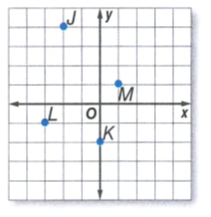
To Write the ordered pair corresponding to each point graphed.
The first number is the x-coordinate, while the second number is the y-coordinate.
Therefore J(−2,4)
Finally, we concluded that the ordered pair corresponding to each point was graphed. ⇒ J(−2,4)
Page 198 Exercise 33 Problem 34
Given:

To Write the ordered pair corresponding to each point graphed.
The first number is the x-coordinate, while the second number is the y-coordinate.
Therefore K(0,2)
Finally, we concluded that the ordered pair corresponding to each point was graphed. ⇒ K(0,2)
Page 198 Exercise 34 Problem 35
Given:
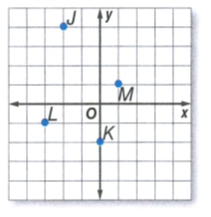
To Write the ordered pair corresponding to each point graphed.
The first number is the x-coordinate, while the second number is the y-coordinate.
Therefore L(−3,−1)
Finally, we concluded that the ordered pair corresponding to each point was graphed. ⇒ L(−3,−1)
Page 198 Exercise 35 Problem 36
Given:

To Write the ordered pair corresponding to each point graphed.
The first number is the x-coordinate, while the second number is the y-coordinate.
Therefore M(1,1)
Finally, we concluded that the ordered pair corresponding to each point was graphed. ⇒ M(1,1)
Page 198 Exercise 36 Problem 37
Given: A(2,4)
To Graph and label each point on the coordinate plane.
The first number is the x-coordinate, while the second number is the y-coordinate.
The required graph is:
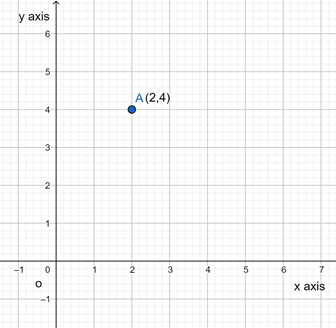
Finally, we Graph and label each point on the coordinate plane

Page 198 Exercise 37 Problem 38
Given: B(−3,1)
To Graph and label each point on the coordinate plane.
The first number is the x-coordinate, while the second number is the y-coordinate.

Finally, we Graph and label each point on the coordinate plane
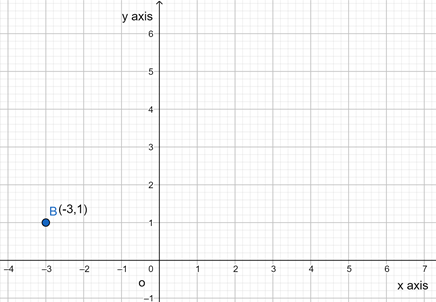
Page 198 Exercise 38 Problem 39
Given: C(2,0)
To Graph and label each point on the coordinate plane.
The first number is the x-coordinate, while the second number is the y-coordinate
The required graph is:

Finally, we plotted Graph and labeled each point on the coordinate plane
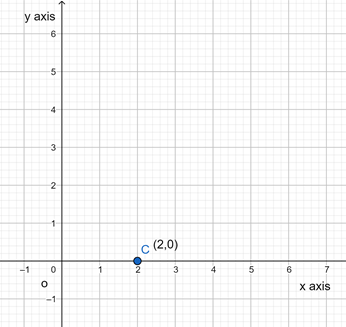
Page 198 Exercise 39 Problem 40
Given:D(−3,−3)
To Graph and label each point on the coordinate plane.
The first number is the x-coordinate, while the second number is the y-coordinate.
The required graph is:

Finally, we Graph and label each point on the coordinate plane

Page 201 Exercise 1 Problem 41
Given:
5 + 6 =_____
To Find each sum. Show your work using drawings.
Given equation is
5 + 6 = 11
⇒ 11
Drawings:
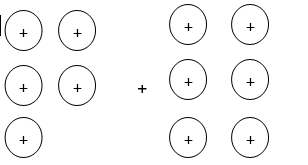
Finally, we find the sum ⇒ 11
Page 201 Exercise 3 Problem 42
Given:
−5 + (−4) =_____
To Find each sum. Show your work using drawings.
Given equation is
−5 + (−4) = −9
⇒ −9
Drawings:

Finally, we find the sum ⇒ −9
Page 201 Exercise 4 Problem 43
Given:
7 + 3 = _____
To Find each sum. Show your work using drawings.
Given equation is
7 + 3 = 10
⇒ 10
Drawings:
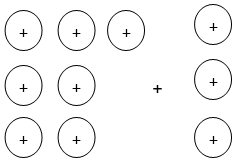
Finally, we find the sum ⇒ 10
Page 201 Exercise 6 Problem 44
Given:
−2 + 7 =_____
To Find each sum. Show your work using drawings.
−2 + 7 = 5
⇒ 5
Drawings:
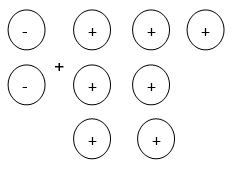
Finally, we find the sum ⇒ 5
Page 201 Exercise 7 Problem 45
Given:
8 + (−3) =_____
To Find each sum. Show your work using drawings.
Given equation is
8 + (−3) = 5
⇒ 5
Drawings:
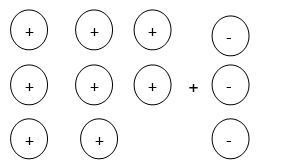
Finally, we find the sum ⇒ 5
Page 201 Exercise 8 Problem 46
Given:
3 + (−6)=_____
To Find each sum. Show your work using drawings.
Given equation is
3 + (−6) =−3
⇒ −3
Drawings:
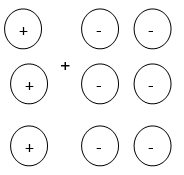
Finally, we find the sum ⇒−3
Page 202 Exercise 10 Problem 47
Given:

To complete the table.
The given equation is
7 + (−12) = − 5
⇒ −5
Sign of addend with greatest absolute value: Negative
Sign of sum: Negative

Finally, we complete the table.

Page 202 Exercise 11 Problem 48
Given:

To complete the table.
Given equation is
−4 + 9 = 5
⇒ 5
Sign of addend with greatest absolute value: Positive
Sign of sum: Positive

Finally, we complete the table.

Page 202 Exercise 12 Problem 49
Given:

To complete the table.
-12 + 20 = 8
⇒ 8
Sign of addend with greatest absolute value: Positive
Sign of sum: Positive

Finally, we complete the table.

Page 202 Exercise 13 Problem 50
Given:

To complete the table
The given expression is
15 + (−18) = −3
⇒ −3
Sign of addend with greatest absolute value: Negative
Sign of sum: Negative

Finally, we complete the table.

Page 202 Exercise 17 problem 51
Given:
First Round = −100
Second Round = −250
Third Round = 500
To Find the contestant’s total number of points. Explain your reasoning
The total number of points is the sum of all points.
The equation is
⇒ −100 −250 + 500
⇒ (−350) + 500
⇒ 150
Finally, we concluded that the contestant’s total number of points ⇒ 150 points
Page 202 Exercise 18 Problem 52
The sum of two integers is Negative, If
Both integers are negative
One integer is negative and the other is positive, while the absolute value of the negative integer is more than the absolute value of the positive integer.
Finally, we concluded that the sum of two integers is Negative. If Both integers are negative or One integer is negative and the other is positive, while the absolute value of the negative. An integer is more than the absolute value of the positive integer.
